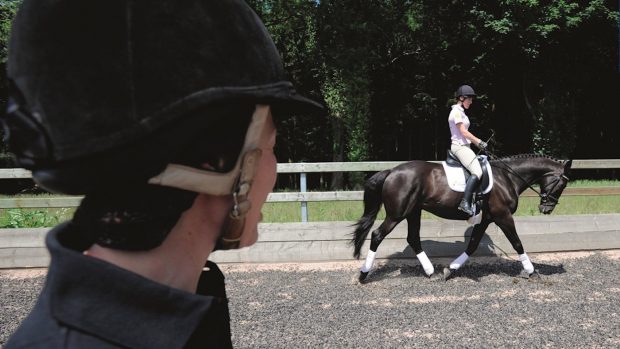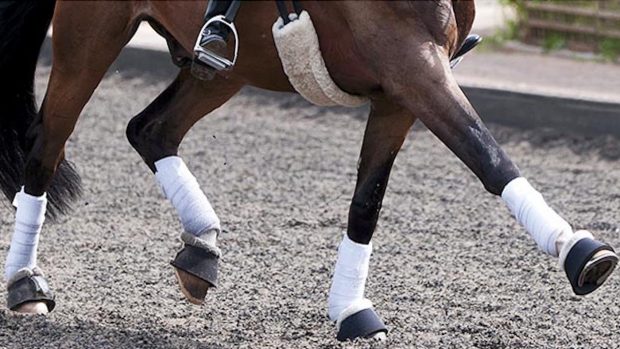When thinking about how to get your horse on the bit, it is important that your horse is working correctly from behind into a soft contact. Before you start schooling, your horse needs to be in good form both mentally and physically. Make sure your horse is up to date with their regular health checks, such as teeth and physio, as well as ensuring your tack is comfortable and well fitting.
{"content":"PHA+PGRpdiBjbGFzcz0iYWQtY29udGFpbmVyIGFkLWNvbnRhaW5lci0tbW9iaWxlIj48ZGl2IGlkPSJwb3N0LWlubGluZS0xIiBjbGFzcz0iaXBjLWFkdmVydCI+PC9kaXY+PC9kaXY+PGRpdiBpZD0idGFib29sYS1taWQtYXJ0aWNsZSI+PC9kaXY+PHNjcmlwdD53aW5kb3cuX3RhYm9vbGFTbG90cz13aW5kb3cuX3RhYm9vbGFTbG90c3x8W107d2luZG93Ll90YWJvb2xhU2xvdHMucHVzaCh7Im1vZGUiOiJ0aHVtYm5haWxzLWEtbWlkIiwiY29udGFpbmVyIjoidGFib29sYS1taWQtYXJ0aWNsZSIsInBsYWNlbWVudCI6Ik1pZCBBcnRpY2xlIiwidGFyZ2V0X3R5cGUiOiJtaXgifSk7PC9zY3JpcHQ+PHNlY3Rpb24gaWQ9ImVtYmVkX2NvZGUtMzYiIGNsYXNzPSIgcy1jb250YWluZXIgc3RpY2t5LWFuY2hvciBoaWRlLXdpZGdldC10aXRsZSB3aWRnZXRfZW1iZWRfY29kZSBwcmVtaXVtX2lubGluZV8xIj48ZGl2IHN0eWxlPSJwYWRkaW5nOiAwcHggIWltcG9ydGFudDsiPjxkaXYgaWQ9InBpYW5vLXBheXdhbGwtbWV0ZXItYmFycmllciIgc3R5bGU9InRleHQtYWxpZ246IGNlbnRlcjsgdmVydGljYWwtYWxpZ246IG1pZGRsZTsiPjwvZGl2PjwvZGl2Pg0KDQo8c3R5bGU+DQojcGlhbm8tcGF5d2FsbC1tZXRlci1iYXJyaWVyIC50cC1jb250YWluZXItaW5uZXIgew0KICAgIHBvc2l0aW9uOiBhYnNvbHV0ZTsNCiAgICBoZWlnaHQ6IDk5OTk5cHggIWltcG9ydGFudDsNCiAgICBiYWNrZ3JvdW5kOiBsaW5lYXItZ3JhZGllbnQoMTgwZGVnLCB0cmFuc3BhcmVudCA2MDBweCwgd2hpdGUgODUwcHgpOw0KfQ0KPC9zdHlsZT48L3NlY3Rpb24+PHNlY3Rpb24gaWQ9ImtleXN0b25lLXZvZXAtd2lkZ2V0LTMiIGNsYXNzPSIgcy1jb250YWluZXIgc3RpY2t5LWFuY2hvciBrZXlzdG9uZS12b2VwLXdpZGdldCBwcmVtaXVtX2lubGluZV8xIj4KPGRpdiBjbGFzcz0iandwbGF5ZXItY29udGFpbmVyIGp3cGxheWVyLW1hcmdpbi1ib3R0b20iPgo8ZGl2IGNsYXNzPSJqd3BsYXllci13cmFwcGVyIj4KPGRpdiBjbGFzcz0iandwbGF5ZXItbWluaW1pemUtY2xvc2UiPgoJCQkJPHN2ZyB4bWxucz0iaHR0cDovL3d3dy53My5vcmcvMjAwMC9zdmciIGNsYXNzPSJqdy1zdmctaWNvbiBqdy1zdmctaWNvbi1jbG9zZSIgdmlld0JveD0iMCAwIDI0MCAyNDAiIGZvY3VzYWJsZT0iZmFsc2UiPgoJCQkJCTxwYXRoIGQ9Ik0xMzQuOCwxMjBsNDguNi00OC42YzItMS45LDIuMS01LjIsMC4yLTcuMmMwLDAtMC4xLTAuMS0wLjItMC4ybC03LjQtNy40Yy0xLjktMi01LjItMi4xLTcuMi0wLjJjMCwwLTAuMSwwLjEtMC4yLDAuMkwxMjAsMTA1LjJMNzEuNCw1Ni42Yy0xLjktMi01LjItMi4xLTcuMi0wLjJjMCwwLTAuMSwwLjEtMC4yLDAuMkw1Ni42LDY0Yy0yLDEuOS0yLjEsNS4yLTAuMiw3LjJjMCwwLDAuMSwwLjEsMC4yLDAuMmw0OC42LDQ4LjdsLTQ4LjYsNDguNmMtMiwxLjktMi4xLDUuMi0wLjIsNy4yYzAsMCwwLjEsMC4xLDAuMiwwLjJsNy40LDcuNGMxLjksMiw1LjIsMi4xLDcuMiwwLjJjMCwwLDAuMS0wLjEsMC4yLTAuMmw0OC43LTQ4LjZsNDguNiw0OC42YzEuOSwyLDUuMiwyLjEsNy4yLDAuMmMwLDAsMC4xLTAuMSwwLjItMC4ybDcuNC03LjRjMi0xLjksMi4xLTUuMiwwLjItNy4yYzAsMC0wLjEtMC4xLTAuMi0wLjJMMTM0LjgsMTIweiI+PC9wYXRoPgoJCQkJPC9zdmc+CgkJCTwvZGl2Pgo8ZGl2CgkJCQlkYXRhLXBsYXllcj0iS01VY25SaUkiCgkJCQlkYXRhLWtleT0ic0FPUHZ6bDMiCgkJCQlkYXRhLWxvYWRlZD0iZmFsc2UiCgkJCQljbGFzcz0iandwbGF5ZXIiCgkJCQlpZD0iandwbGF5ZXJfc0FPUHZ6bDNfS01VY25SaUlfMjFfZGl2Ij4KCQkJPC9kaXY+CjwvcD48L2Rpdj4KPC9wPjwvZGl2Pgo8L3NlY3Rpb24+PC9wPgo8aDM+QSBjb3JyZWN0IG91dGxpbmU8L2gzPgo8cD5BIDxhIGhyZWY9Imh0dHBzOi8vd3d3LmhvcnNlYW5kaG91bmQuY28udWsvZmVhdHVyZXMvaG93LXRvLXdvcmsteW91ci1ob3JzZS1pbi1hbi1vdXRsaW5lLTUyOTE1NiI+Y29ycmVjdCBvdXRsaW5lPC9hPiBtZWFucyB0aGF0IHRoZSBwb2xsIGlzIGF0IHRoZSBoaWdoZXN0IHBvaW50IGFuZCB5b3VyIGhvcnNl4oCZcyBmYWNlIGlzIHZlcnRpY2FsLCBvciBqdXN0IGluIGZyb250IG9mIHRoZSB2ZXJ0aWNhbC4gSGlzIG5lY2sgc2hvdWxkIGFyY2ggYWxvbmcgdGhlIHRvcCBsaW5lLCBob3dldmVyIHRoZSBqYXcgYW5kIG11c2NsZSB1bmRlcm5lYXRoIGhpcyBuZWNrIHNob3VsZCBiZSByZWxheGVkIGFuZCBzb2Z0LiBUaGUgYmFjayBhbmQgbG9pbnMgc2hvdWxkIGJlIHN1cHBsZSwgdGhlIHNob3VsZGVycyBzaG91bGQgYmUgYWJsZSB0byBtb3ZlIGZyZWVseSBhbmQgdGhlIGZyb250IGFuZCBiYWNrIGxlZyBqb2ludHMgc2hvdWxkIGZsZXggYW5kIG1vdmUgZXF1YWxseS4gVGhlcmUgc2hvdWxkIGJlIG5vIHRlbnNpb24uPC9wPgo8aDM+T24gdGhlIGJpdDwvaDM+CjxwPklmIHlvdSBoYXZlIGEgY29ycmVjdCBvdXRsaW5lIGFuZCBnb29kIGZvcm0sIGFza2luZyB5b3VyIGhvcnNlIHRvIGdvIG9uIHRoZSBiaXQgc2hvdWxkIHNpbXBseSBpbnZvbHZlIGFza2luZyBoaW0gZm9yIG1vcmUgZW5nYWdlbWVudCBmcm9tIGJlaGluZCwgZW5jb3VyYWdpbmcgdGhlIGZvcmVoYW5kIHRvIGxpZnQgYW5kIGxpZ2h0ZW4uIFRoZSBlbmVyZ3kgbmVlZGVkIHRvIHByb2R1Y2UgYSBjb3JyZWN0IG91dGxpbmUgYmVnaW5zIGluIHRoZSBoaW5kcXVhcnRlcnMgYW5kIGZsb3dzIGZvcndhcmRzIGludG8geW91ciBoYW5kcy48L3A+CjxoMz5BY2NlcHRpbmcgdGhlIGJpdDwvaDM+CjxwPllvdSBzaG91bGQgZW5jb3VyYWdlIHlvdXIgaG9yc2UgdG8gc2VlayB0aGUgcmVpbiBjb250YWN0IGJ5IHRha2luZyBhIHBvc2l0aXZlLCBjb25zaXN0ZW50IGZlZWwuIERvIG5vdCBiZSBoZWF2eSBvbiB0aGUgcmVpbiBvciB1bm5lY2Vzc2FyaWx5IHN0cm9uZy4gV29yayB5b3VyIGhvcnNlIGZvcndhcmRzIGluIGEgZ29vZCByaHl0aG0sIGVuc3VpbmcgeW91ciBwYWNlcyBhcmUgYmFsYW5jZWQgYW5kIHlvdeKAmXJlIHJpZGluZyBoaW0gc3RyYWlnaHQgYmVmb3JlIHBpY2tpbmcgdXAgdGhlIGNvbnRhY3QuPC9wPgo8cD48ZGl2IGNsYXNzPSJhZC1jb250YWluZXIgYWQtY29udGFpbmVyLS1tb2JpbGUiPjxkaXYgaWQ9InBvc3QtaW5saW5lLTIiIGNsYXNzPSJpcGMtYWR2ZXJ0Ij48L2Rpdj48L2Rpdj48c2VjdGlvbiBpZD0iZW1iZWRfY29kZS0zMSIgY2xhc3M9ImhpZGRlbi1tZCBoaWRkZW4tbGcgcy1jb250YWluZXIgc3RpY2t5LWFuY2hvciBoaWRlLXdpZGdldC10aXRsZSB3aWRnZXRfZW1iZWRfY29kZSBwcmVtaXVtX2lubGluZV8yIj48c2VjdGlvbiBjbGFzcz0icy1jb250YWluZXIgbGlzdGluZy0tc2luZ2xlIGxpc3RpbmctLXNpbmdsZS1zaGFyZXRocm91Z2ggaW1hZ2UtYXNwZWN0LWxhbmRzY2FwZSBkZWZhdWx0IHNoYXJldGhyb3VnaC1hZCBzaGFyZXRocm91Z2gtYWQtaGlkZGVuIj4NCiAgPGRpdiBjbGFzcz0icy1jb250YWluZXJfX2lubmVyIj4NCiAgICA8dWw+DQogICAgICA8bGkgaWQ9Im5hdGl2ZS1jb250ZW50LW1vYmlsZSIgY2xhc3M9Imxpc3RpbmctaXRlbSI+DQogICAgICA8L2xpPg0KICAgIDwvdWw+DQogIDwvZGl2Pg0KPC9zZWN0aW9uPjwvc2VjdGlvbj48L3A+CjxoMz5Ib3cgdG8gZ2V0IHlvdXIgaG9yc2Ugb24gdGhlIGJpdDogd2hhdCBjYW4gZ28gd3Jvbmc\/PC9oMz4KPGgzPkFiaWxpdHk8L2gzPgo8cD5BZ2UsIGxldmVsIG9mIHNjaG9vbGluZyBhbmQgY29uZm9ybWF0aW9uIG1heSBhbGwgYWZmZWN0IGhvdyBlYXNpbHkgeW91ciBob3JzZSBmaW5kcyBpdCB0byB3b3JrIGluIGFuIG91dGxpbmUsIGVuZ2FnZSBoaXMgaG9ja3MgYW5kIHN0cmV0Y2ggdGhyb3VnaCBoaXMgdG9wbGluZS4gQWNjb3VudCBmb3IgdGhpcyBhbmQgZG9u4oCZdCBhc2sgdG9vIG11Y2ggdG9vIHNvb24uIFNlZWsgbGVzc29ucyBmcm9tIGFuIGV4cGVyaWVuY2VkIGluc3RydWN0b3IuPC9wPgo8aDM+QW4gaW5jb3JyZWN0IG91dGxpbmU8L2gzPgo8cD5BIOKAmGZhbHNl4oCZIG91dGxpbmUgaXMgd2hlbiB5b3VyIGhvcnNlIHR1Y2tzIGhpcyBub3NlIGludG8gdGhlIHBvc2l0aW9uIGl0IHNob3VsZCBiZSwgYnV0IGlzbuKAmXQgdXNpbmcgaGltc2VsZiBjb3JyZWN0bHkuIElmIHRoaXMgaGFwcGVucyB5b3Ugc2hvdWxkIGdvIGJhY2sgdG8gYmFzaWNzIGFuZCBzY2hvb2wgaGltIHRvIGNvcnJlY3QgdGhpcyBwcm9ibGVtLiBJdOKAmXMgYSBnb29kIGlkZWEgdG8gcnVsZSBvdXQgcGFpbiwgZmVhciwgYW5kIGEgbGFjayBvZiB1bmRlcnN0YW5kaW5nIGZpcnN0LjwvcD4KPGgzPk92ZXJiZW5kaW5nPC9oMz4KPHA+SWYgeW91ciBob3JzZSBvdmVyYmVuZHMgeW914oCZbGwgZmluZCB0aGF0IGhlIHRha2VzIHRvbyBtdWNoIGNvbnRhY3QuIEJlIHN1cmUgdGhhdCB5b3UgYXJlIG5vdCBoZWF2eSBpbiB5b3VyIGhhbmQg4oCTIHRyeSB0byB3b3JrIHlvdXIgaG9yc2UgaW50byBhIGxpZ2h0ZXIgY29udGFjdC48L3A+CjxkaXYgY2xhc3M9ImFkLWNvbnRhaW5lciBhZC1jb250YWluZXItLW1vYmlsZSI+PGRpdiBpZD0icG9zdC1pbmxpbmUtMyIgY2xhc3M9ImlwYy1hZHZlcnQiPjwvZGl2PjwvZGl2Pgo8aDM+QmVoaW5kIHRoZSBiaXQ8L2gzPgo8cD5JZiB5b3VyIGhvcnNlIGlzIGJlaGluZCB0aGUgYml0LCBoZSB3aWxsIG5vdCBhY2NlcHQgdGhlIGNvbnRhY3QgYW5kIHdpbGwgdHVjayBoaXMgbm9zZSBpbnRvIGhpcyBjaGVzdC4gWW91IHdpbGwgZmluZCB0aGF0IHRoZSBwb2xsIGlzbuKAmXQgaW4gdGhlIGhpZ2hlc3QgcG9pbnQgYW5kIGhpcyBmYWNlIGlzIGJlaGluZCB0aGUgdmVydGljYWwuIEJlIHN1cmUgdGhhdCB5b3UgYXJlIGFza2luZyB5b3VyIGhvcnNlIHRvIHdvcmsgZm9yd2FyZHMgd2l0aCBpbXB1bHNpb24uPC9wPgo8aDM+QWJvdmUgdGhlIGJpdDwvaDM+CjxwPklmIHlvdXIgaG9yc2UgaXMgYWJvdmUgdGhlIGJpdCBoZSB3aWxsIGhvbGQgaXMgaGVhZCBoaWdoLCBtZWFuaW5nIHRoYXQgaGUgd2lsbCBob2xsb3cgdGhyb3VnaCBoaXMgYmFjay4gVGhpcyB3aWxsIGNhdXNlIHRoZSBoaW5kcXVhcnRlcnMgdG8gdHJhaWwuIFdvcmsgb24gaGlzIHNjaG9vbGluZyBhbmQgZW5jb3VyYWdlIGhpbSB0byByZWxheCBmb3J3YXJkcyBpbnRvIHRoZSBjb250YWN0LjwvcD4KPGRpdiBjbGFzcz0iYWQtY29udGFpbmVyIGFkLWNvbnRhaW5lci0tbW9iaWxlIj48ZGl2IGlkPSJwb3N0LWlubGluZS00IiBjbGFzcz0iaXBjLWFkdmVydCI+PC9kaXY+PC9kaXY+CjxwPgo="}
Search upcoming events at www.equoevents.com
Horse & Hound magazine, out every Thursday, is packed with all the latest news and reports, as well as interviews, specials, nostalgia, vet and training advice. Find how you can enjoy the magazine delivered to your door every week, plus options to upgrade to access our H&H Plus online service which brings you breaking news as it happens as well as other benefits.



